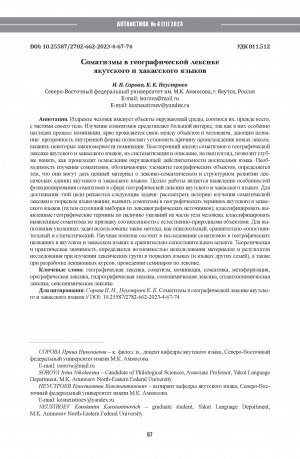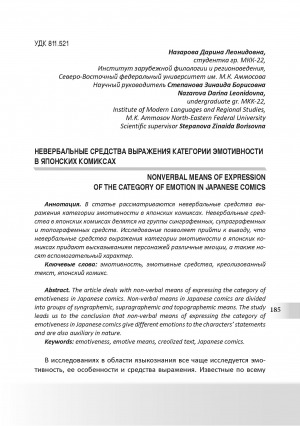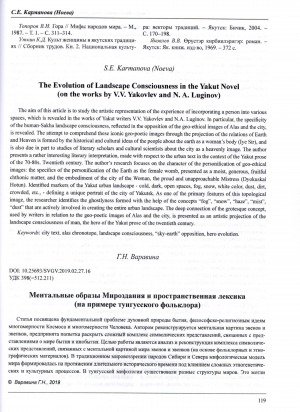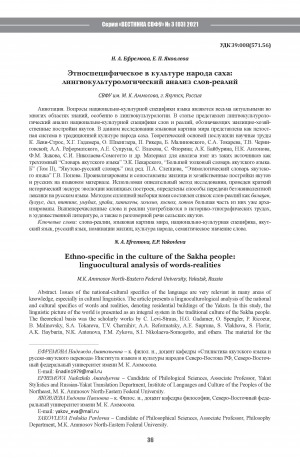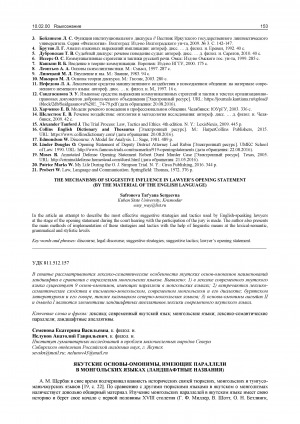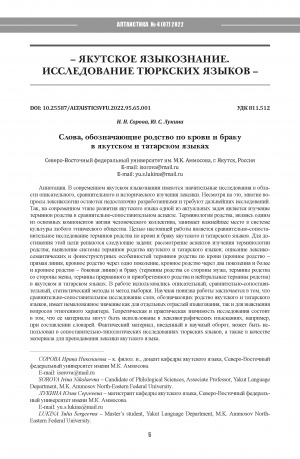
Лексико-семантическая характеристика эмотива "страх" в японских рассказах жанра кайдан = Lexical and semantic characteristics of the emotive “fear” in Japanese kaidan stories
Статья в журнале
Русский
821.521
10.25587/2782-6627-2025-1-27-35
текст; эмотивность; семантика; лексика; жанр кайдан; эмотив "страх"; японский язык; японская литература; лексико-семантические особенности; языковая картина мира; text; emotiveness; semantics; vocabulary; kaidan genre; emotive “fear”; Japanese language; Japanese literature; lexical and semantic features; linguistic picture of the world
Вестник Северо-Восточного федерального университета им. М. К. Аммосова. Серия "Алтаистика". - 2025. - N 1 (16)
This article is devoted to the problem of emotiveness as a linguistic category expressed by specific means of expressing emotions in the text. The relevance of the study is due to the fact that detailing the ethnocultural specificity of the sign reflection of the emotive component of the linguo-semiotic picture of the world helps to improve intercultural understanding and strengthen ties between different communities. The study is also of interest in view of the growing interest in studying the problem of emotiveness as one of the most important aspects of communication. The purpose of the study is to identify the lexical and semantic features of the representation of the emotive “fear” in the works of the Japanese genre kaidan. As a result of the study, we come to the conclusion that the analysis of synonymous lexemes expressing “fear” in the Japanese language shows that each lexical unit is distinguished by several differential semantic features, while Japanese vocabulary has a bright figurative internal form embedded in the semantics of the word itself, therefore it is less dependent on a specific context or compatibility. In the Japanese stories of the kaidan genre that we selected, the semantics of the lexical units of the Japanese language expressing the concept of “fear” varies in a fairly wide range of shades depending on the nature of the threat, the cause and the specifics of experiencing this feeling. Thus, in the texts of the analyzed Japanese stories, intense emotions of “horror”, “fright”, “anxiety” are most often conveyed, rather than prolonged “phobia” or “fear”. Thus, the lexical-semantic analysis of the components of the emotive “fear” showed that in the texts of Japanese kaidan stories, verbs are predominantly used that convey actions and reactions (conscious or unconscious), rather than adjectives and adverbs that describe the feeling or state of fear.
Руфова, Е. С. Лексико-семантическая характеристика эмотива "страх" в японских рассказах жанра кайдан / Е. С. Руфова, К. Д. Мосорина ; Северо-Восточный федеральный университет им. М. К. Аммосова // Вестник Северо-Восточного федерального университета им. М. К. Аммосова. Серия "Алтаистика". - 2025. - N 1 (16). - С. 27-35. - DOI: 10.25587/2782-6627-2025-1-27-35
DOI: 10.25587/2782-6627-2025-1-27-35
- Языкознание. Филология. Художественная литература > Литература. Литературоведение > Прочие литературные жанры,
- Языкознание. Филология. Художественная литература > Литература. Литературоведение > Теория литературы. Изучение литературы. Литературная техника > Художественная литература на отдельных языках,
- НАУКА ЯКУТИИ > ЯЗЫКОЗНАНИЕ. ФИЛОЛОГИЯ. ЛИТЕРАТУРОВЕДЕНИЕ. ХУДОЖЕСТВЕННАЯ ЛИТЕРАТУРА > Литература. Литературоведение.
Войдите в систему, чтобы открыть документ
